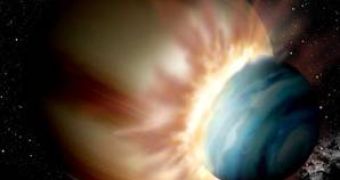The study of exoplanets and other solar systems is in high gear ever since the discovery of the first extrasolar planet back in 1996, finding new and interesting facts about solar systems formation processes. The same thing is available for an object orbiting a distant star, found nearly four years ago. The gas giant 2M1207B orbits around an old brown-dwarf star located at a distance of about 170 light years away from Earth, in the Centaurus constellation.
While measuring the characteristics of the planet related to the approximated age of the alien solar system, astronomers discovered that the gas giant is actually hotter and more luminous than theoretical calculations predicted. This small fact raised some doubts about the true nature of the object. Was it really a planet or a brown dwarf? A quick mass estimation of the elusive object revealed that the mass it packs is not enough for it to form a brown dwarf, as it is comparable to that of the planet Jupiter. Thus, the astronomers concluded that it must be a planet.
Nevertheless, the mystery regarding its surface temperature and its enhanced brightness still remained. What kind of interactions would enable a planet to stay hot for such a long time since its birth? In a recently published new study, Eric Mamajek of the Harvard-Smithsonian Center for Astrophysics proposed a planetary collision. The gas giant, currently estimated to be about a quarter of Jupiter's total weight, could have collided with a rocky planet about three times the size of the Earth, which would explain why the 1,300 degrees Celsius body didn't cool to 700 degrees Celsius or less, over time.
This cooling process would have required at least 8 million years, a less shorter time than the age of the alien solar system. Similar events might have taken place in our solar system as well and our moon might be one of the results of such planetary collisions. Another example is that of the planet Uranus, which has a tilt almost parallel to the plane of orbit around the Sun, meaning planetary collisions are quite common during solar system formation.
Although presenting a temperature higher than usual, the Saturn-sized planet emits relatively low amounts of radiation, related to its total surface area, which might be due to a debris disk surrounding the planet that filters a part of the light given off. In addition to the hot state of the 2M1207B object, it might become the first planet outside the solar system ever photographed, as most of the discovered planets around other stars are mostly invisible to the optical telescopes.

 14 DAY TRIAL //
14 DAY TRIAL //